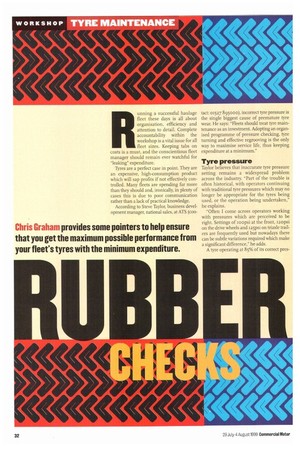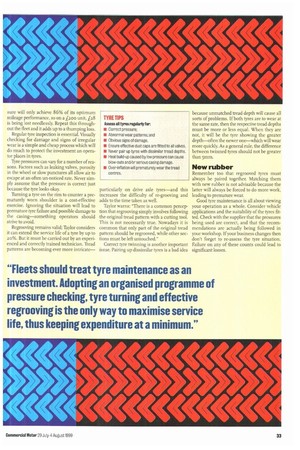R unning a successful haulage fleet these days is all about
Page 34

Page 35

If you've noticed an error in this article please click here to report it so we can fix it.
organisation, efficiency and attention to detail. Complete accountability within the workshop is a vital issue for all fleet sizes. Keeping tabs on costs is a must, and the conscientious fleet manager should remain ever watchful for leaking" expenditure.
Tyres are a perfect case in point. They are an expensive, high-consumption product which will sap profits if not effectively controlled. Many fleets are spending far more than they should and, ironically, in plenty of cases this is due to poor communication rather than a lack of practical knowledge.
According to Steve Taylor, business development manager, national sales, at ATS (con tact: 01527 895000), incorrect tyre pressure is the single biggest cause of premature tyre wear. He says: "Fleets should treat tyre maintenance as an investment. Adopting an organised programme of pressure checking, tyre turning and effective regrooving is the only way to maximise service life, thus keeping expenditure at a minimum."
Tyre pressure
Taylor believes that inaccurate tyre pressure setting remains a widespread problem across the industry. "Part of the trouble is often historical, with operators continuing with traditional tyre pressures which may no longer be appropriate for the tyres being used, or the operation being undertaken," he explains.
"Often I come across operators working with pressures which are perceived to be right. Settings of roopsi at the front, t2opsi on the drive wheels and 12.5psi on triaxle tra ilers are frequently used but nowadays there can be subtle variations required which make a significant difference," he adds.
A tyre operating at 85% of its correct pres sure will only achieve 86% of its optimum mileage performance, so on a £200 unit, /28 is being lost needlessly. Repeat this throughout the fleet and it adds up to a thumping loss.
Regular tyre inspection is essential. Visually checking for damage and signs of irregular wear is a simple and cheap process which will do much to protect the investment an operator places in tyres.
Tyre pressures can vary for a number of reasons. Factors such as leaking valves, porosity in the wheel or slow punctures all allow air to escape at an often un-noticed rate. Never simply assume that the pressure is correct just because the tyre looks okay.
Turning a tyre on the rim to counter a prematurely worn shoulder is a cost-effective exercise. Ignoring the situation will lead to premature tyre failure and possible damage to the casing—something operators should strive to avoid.
Regrooving remains valid; Taylor considers it can extend the service life of a tyre by up to zo%. But it must be carried out by an experienced and correctly trained technician. Tread patterns are becoming ever more intricate—
particularly on drive axle tyres—and this increases the difficulty of re-grooving and adds to the time taken as well.
Taylor warns: "There is a common perception that regrooving simply involves following the original tread pattern with a cutting tool. This is not necessarily true. Nowadays it is common that only part of the original tread pattern should be regrooved, while other sections must be left untouched."
Correct tyre twinning is another important issue. Pairing up dissimilar tyres is a bad idea hccause unmatched tread depth will cause all sorts of problems. If both tyres are to wear at the same rate, then the respective tread depths must be more or less equal. When they are not, it will be the tyre showing the greater depth—often the newer one—which will wear more quickly. As a general rule, the difference between twinned tyres should not be greater than 5mm.
New rubber
Remember too that regrooved tyres must always be paired together. Matching them with new rubber is not advisable because the latter will always be forced to do more work, leading to premature wear.
Good tyre maintenance is all about viewing your operation as a whole. Consider vehicle applications and the suitability of the tyres fitted. Check with the supplier that the pressures being used are correct, and that the recommendations are actually being followed in your workshop. If your business changes then don't forget to re-assess the tyre situation. Failure on any of these counts could lead to significant losses.












































































































